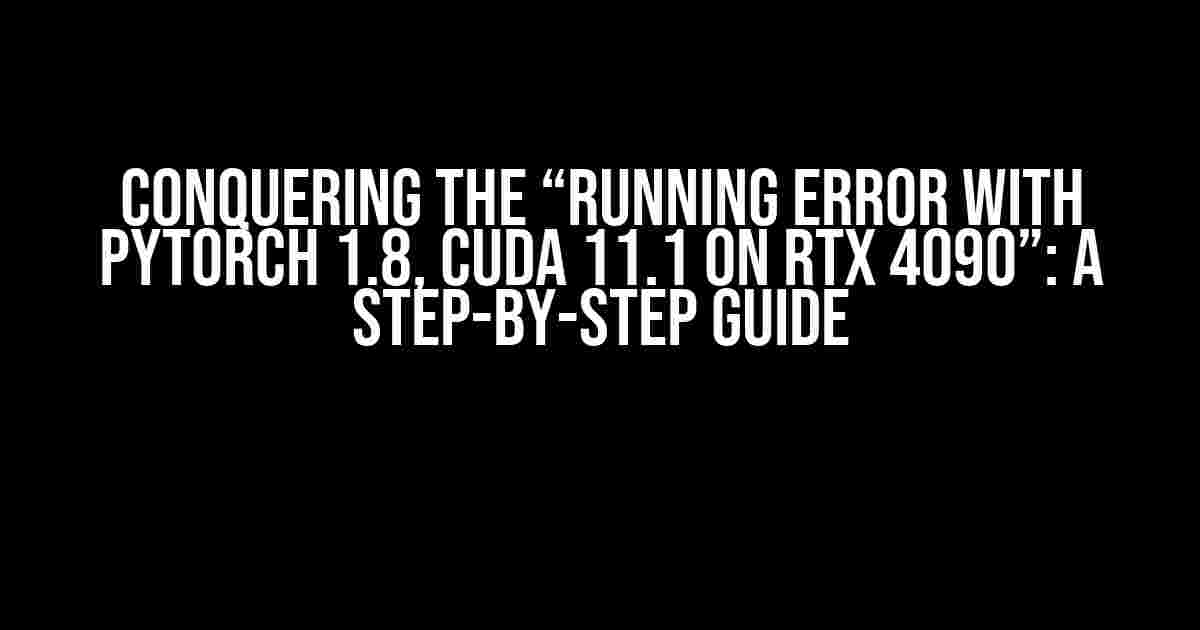Are you tired of encountering frustrating errors when trying to run PyTorch 1.8 with CUDA 11.1 on your shiny new RTX 4090 GPU? You’re not alone! Many developers have struggled with this issue, but fear not, dear reader, for we’re about to dive into a comprehensive guide to help you troubleshoot and overcome this hurdle.
Understanding the Error
Before we dive into the solutions, it’s essential to understand the nature of the error. The “Running Error with PyTorch 1.8, CUDA 11.1 on RTX 4090” typically manifests in one of the following ways:
RuntimeError: CUDA error: invalid device ordinalCUDA runtime error: device-side assert triggeredtorch.cuda.Cuda.RuntimeError: CUDA error: unknown error
These errors often indicate a mismatch between the PyTorch version, CUDA version, and the RTX 4090 GPU. But don’t worry, we’ll get to the bottom of this!
Prerequisites and System Requirements
Before we begin, ensure you meet the following prerequisites and system requirements:
| Component | Version/Specification |
|---|---|
| PyTorch | 1.8 |
| CUDA | 11.1 |
| RTX GPU | 4090 |
| Operating System | Ubuntu 20.04 or later (64-bit) |
| GPU Driver | NVIDIA Driver Version 470.57.02 or later |
Troubleshooting Steps
Let’s get started with the troubleshooting steps. Follow these instructions carefully, and we’ll get your PyTorch 1.8, CUDA 11.1, and RTX 4090 combination up and running in no time!
Step 1: Verify PyTorch Installation
pip install torch torchvision torchaudio --extra-index-url https://download.pytorch.org/whl/cu111
Run the above command to ensure PyTorch 1.8 is installed correctly with CUDA 11.1 support.
Step 2: Check CUDA Installation
nvidia-smi
Run the `nvidia-smi` command to verify CUDA 11.1 is installed and the RTX 4090 GPU is recognized.
Step 3: Update GPU Driver
Make sure you’re running the latest NVIDIA GPU driver (Version 470.57.02 or later). You can check the driver version using:
nvidia-smi -q | grep "Driver Version"
Step 4: Set Environment Variables
Set the following environment variables to ensure PyTorch can find the CUDA installation:
export CUDA_HOME=/usr/local/cuda-11.1 export LD_LIBRARY_PATH=$CUDA_HOME/lib64:$LD_LIBRARY_PATH export PATH=$CUDA_HOME/bin:$PATH
Step 5: Verify PyTorch-CUDA Compatibility
Run the following code snippet to verify PyTorch 1.8 is compatible with CUDA 11.1:
import torch print(torch.version.cuda) print(torch.backends.cudnn.version()) print(torch.cuda.get_device_name(0))
This should output the CUDA version, cuDNN version, and the RTX 4090 GPU name.
Step 6: Test PyTorch with CUDA
Create a simple PyTorch script to test CUDA functionality:
import torch
device = torch.device("cuda:0" if torch.cuda.is_available() else "cpu")
print("Device:", device)
x = torch.randn(1, 2, 3, 4, device=device)
print(x)
If everything is set up correctly, this script should run without errors and print the device information and the tensor `x`.
Common Errors and Solutions
During the troubleshooting process, you might encounter some common errors. Here are some solutions to help you overcome them:
Error: “CUDA error: invalid device ordinal”
Solution:
- Check that the RTX 4090 GPU is recognized by the system using `lspci | grep -i nvidia`.
- Verify that the CUDA installation is correct and the `CUDA_HOME` environment variable is set.
Error: “CUDA runtime error: device-side assert triggered”
Solution:
- Update the NVIDIA GPU driver to the latest version.
- Check the PyTorch version and ensure it’s compatible with CUDA 11.1.
Conclusion
By following these steps and troubleshooting common errors, you should now be able to run PyTorch 1.8 with CUDA 11.1 on your RTX 4090 GPU without encountering the “Running Error” issue. Remember to stay patient, persistent, and vigilant when troubleshooting, and you’ll be well on your way to unleashing the full potential of your RTX 4090 with PyTorch!
Frequently Asked Question
If you’re struggling to get PyTorch 1.8 to run smoothly with CUDA 11.1 on your shiny new RTX 4090, you’re not alone! We’ve got the most common issues covered below.
Why do I get a “RuntimeError: CUDA error: invalid device ordinal” when running PyTorch 1.8 on my RTX 4090?
This error usually occurs when PyTorch can’t find the correct CUDA device. Try setting the visible devices explicitly by setting the `CUDA_VISIBLE_DEVICES` environment variable to the index of your RTX 4090. For example, if your RTX 4090 is device 0, set `CUDA_VISIBLE_DEVICES=0` before running your PyTorch script.
I’m getting a “cudnn(handle): Error: CUDNN_STATUS_NOT_INITIALIZED” error when running my PyTorch model. What’s going on?
This error usually indicates that CuDNN is not properly initialized. Make sure you’ve installed the correct version of CuDNN (CuDNN 8.2.2.26 for CUDA 11.1) and that your PyTorch installation is correctly linked against it. You can try reinstalling PyTorch with CuDNN support or check that your `LD_LIBRARY_PATH` environment variable points to the correct CuDNN installation.
Why is my PyTorch model running so slowly on my RTX 4090?
There are many potential reasons for slow performance, but a common culprit is incorrect memory allocation. Make sure you’re using the correct CUDA device (see question 1) and that your model is properly pinned to the device using `model.to(device)`. Additionally, consider using `torch.cuda.amp` for automatic mixed precision training to take advantage of the RTX 4090’s tensor cores.
I’m getting a “Out of memory” error when trying to allocate a large tensor on my RTX 4090. What can I do?
The RTX 4090 has a massive amount of VRAM, but it’s not infinite! If you’re running out of memory, try reducing the batch size or model size, or use model parallelism to split the model across multiple GPUs. You can also consider using `torch.cuda.empty_cache()` to release cached memory or `torch.backends.cudnn.benchmark = True` to enable CuDNN’s benchmark mode for better memory allocation.
How can I verify that PyTorch 1.8 is correctly using my RTX 4090 and CUDA 11.1?
You can use the `nvidia-smi` command to check that your RTX 4090 is recognized and that PyTorch is correctly using it. Additionally, you can use `import torch; print(torch.version.cuda)` to verify that PyTorch is using CUDA 11.1. Finally, you can use `import torch; torch.cuda.device_count()` to check the number of available CUDA devices.
